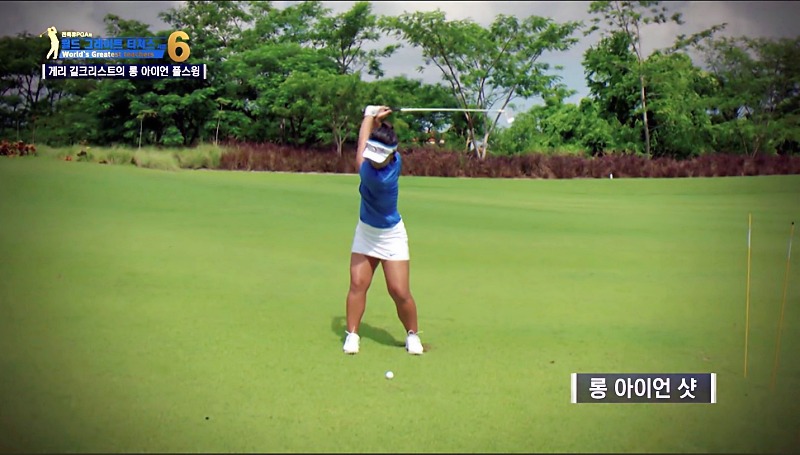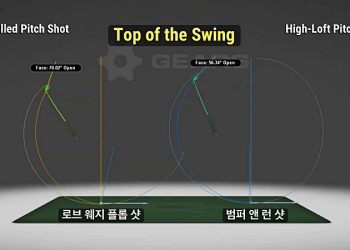
롱 아이언을 잘 치기란 쉽지 않다. 숏 아이언이나 미드 아이언에 비해서 실패 확률이 높다. 스윙도 상대적으로 급하다. 체력적, 심리적인 조건 모두 롱 아이언 샷을 힘들게 한다.
이렇게 연습해 보자. 먼저 목표 쪽으로 2개의 에임 스틱을 꽂아둔다. 좁게 간격을 벌려 놓고 볼이 그 사이로 빠져나가게 연습하는 것이다. 롱 아이언을 칠 때 이렇게 방향 설정을 해 놓고 연습하면 잘못된 샷의 원인 분석에 도움이 된다.
롱 아이언을 잘 다루기 위해서는 클럽 페이스에 대한 이해가 중요하다. 볼의 방향은 클럽 패스의 움직임보다 페이스 앵글의 영향을 더 많이 받는다. 순서대로 볼의 방향을 깊이 이해하기 위해선, 먼저 볼의 날아가는 움직임을 추적(Tracer)한다. 그리고 평면상에서 볼의 방향과 높이를 파악한다. 즉 수평면과 수직면(Side/Top)에서 나타난 볼의 휘어짐과 탄도를 관찰한다.
클럽 패스와 페이스 앵글의 임팩트 순간의 각도 차이를 관찰한다. 클럽 헤드의 진행과 클럽 페이스 앵글의 차이도 살핀다. 그리고 볼이 페이스 면에 만들어낸 접촉 흔적을 살핀다. 스윙의 최저점을 알아보기 위해 스윙 플레이도 분석한다. 마지막으로 볼의 스핀이 최적 상태로 만들어졌는지 임팩트 순간을 수치로 분석한다.
매우 복잡해 보이지만 이러한 과정이 있어야 롱 아이언 샷을 분석할 수 있다. 영어로 정리하면 Ball’s Tracer, Side/Top, Video D/L, Impact Location, Swing Plane, and Impact.을 분석하는 것이다.
롱 아이언 샷은 골퍼의 수준마다 큰 차이를 보인다. 이러한 문제는 체력적, 심리적 부분과도 연관이 있다. 그리고 샷을 하는 상황에 따라서도 큰 차이를 보인다.
실제 롱 아이언 샷은 임팩트 순간에 볼과 클럽 페이스면의 접촉 시간에 영향을 많이 받는다. 접촉 시간은 아주 순간적이다. 이 순간의 시간이 길수록 좋다. 임팩트 순간 클럽 페이스의 미세한 열림과 닫힘이 방향과 거리에 영향을 크게 준다.
볼을 똑바로 멀리 보내기 위해선 어드레스의 정렬과 볼의 위치를 꼼꼼히 살펴야 한다. 기본적인 출발이 전체 스윙에 기본이 되기 때문이다. 임팩트 순간에 클럽 패스와 페이스 앵글 각도 차이를 아주 작게 만들어야 한다.
롱 아이언 샷에서 백스윙 크기와 진행 시 올바른 궤도와 충분한 어깨 회전이 필수다. 즉 100%의 백스윙 크기를 필요로 한다. 롱 아이언 샷 실수의 대부분은 백스윙이 작은 데서 발생한다. 긴 클럽은 충분한 백스윙에 의해 샷의 거리와 방향이 시작된다. 충분치 않은 백스윙은 올바른 스윙 타이밍과 리듬도 망치게 한다. 또한 자신의 신체적인 상태를 고려하지 않은 오버된 백스윙은 다운스윙의 스매시를 낮은 수치로 만든다.
정면 자세에서 어드레스는 상체의 기울인 각도가 중요하다. 상체 각을 살짝 오른쪽을 기울여 임팩트의 어택 앵글을 낮게 만든다. 볼의 위치는 중심보다 상대적으로 왼쪽에 둔다. 스윙의 로우 포인트가 미드 아이언 샷보다 작게 만든다. 디봇의 흔적도 깊지 않게 만든다. 개인의 체력적인 특성을 고려할 때 장타를 치는 골퍼들은 볼을 좀 더 중심 쪽으로 옮긴다.
서두에서 롱 아이언은 체력적인 부분과 심리적인 부분에서 영향을 받는다고 했다. 5번 아이언 샷을 가지고 연습할 때 선수들에게 7번 아이언이라고 하면서 클럽을 주곤 한다. 결과적으로 긍정적인 효과를 얻을 때가 많다. 심리적으로 편하게 느낄 때 스윙도 쉬워지기 때문이다.
☞ 전욱휴는…
골프 칼럼니스트. PGA 클래스A 멤버이자 공인 티칭 및 코칭 강사다. SBS, MBC, JTBC, YTN 등의 골프 채널에서 진행자 및 해설자로 활약했다. 현재 애틀랜타에서 골프 레슨 및 골프 관련 비즈니스를 하고 있다. chungolf@gmail.com
[Dr Eric Chun’s Golf Lesson] 14. Long Iron Shots as Easily Hit as Short Irons
When practicing with long irons, think of them as mid irons, and the swing becomes easier.
Hitting long irons well is not easy. Compared to short irons or mid irons, the probability of failure is higher. The swing is also relatively more abrupt. Both physical and psychological conditions can make long iron shots difficult.
First, place two aiming sticks toward the target direction. Set them narrowly apart so that the ball passes between them during practice. Establishing direction from the start when hitting long irons helps in analyzing the causes of incorrect shots.
To handle long irons well, understanding the clubface is essential. The direction of the ball is more influenced by the face angle than by the club path movement. To deeply understand the direction of the ball sequentially, first trace the ball’s flight (tracer). Then, grasp the direction and height of the ball on a plane. Observe the ball’s curvature and trajectory as seen on the horizontal and vertical planes (Side/Top). Examine the angle difference between the club path and face angle at the impact moment. Also, check the difference between the clubhead’s progress and the clubface angle. Look at the contact marks created on the face surface of the ball. Then, to determine the swing’s low point, analyze the swing plane as well. Lastly, analyze the impact moment in numerical terms to see if the ball’s spin was optimized. Although it seems complicated, this process is necessary for analyzing long iron shots. In other words, analyzing a long iron swing requires more steps than analyzing issues with short or mid irons.
Analyze: Ball’s Tracer, Side/Top, Video D/L, Impact Location, Swing Plane, and Impact.
The issues with long iron shots vary significantly depending on the golfer’s level. These issues should also be considered from physical and psychological aspects and vary greatly depending on the situation in which the shot is taken.
The actual long iron shot is heavily influenced by the contact time between the ball and the clubface at the impact moment. This moment happens in an instant, and the longer this time, the better. The slight opening and closing of the clubface at the impact moment significantly affect direction and distance.
To send the ball straight and far, carefully check the alignment of the address and the position of the ball. The basic setup is crucial as it becomes the foundation for the entire swing. The angle difference between the club path and face angle at the impact moment should be minimized. A proper swing path and sufficient shoulder rotation are essential for the backswing’s size and progress in long iron shots. In other words, it requires 100% backswing size. Most mistakes in long iron shots occur when the backswing is not sufficiently large. A longer club starts its distance and direction shot by a sufficient backswing. A smaller backswing not only ruins the timing and rhythm of the swing but also, if overdone without considering one’s physical condition, lowers the smash factor in the downswing.
In the frontal address position, the angle of the upper body tilt plays an important role. Slightly tilt the upper body to the right to lower the attack angle of the impact. Place the ball relatively to the left of the center. Make the swing low point smaller than in mid iron shots. The divot marks should also not be deep. For golfers with physical strength, move the ball slightly more toward the center.
As mentioned at the beginning, long irons are influenced by physical and psychological aspects. When practicing with a 5-iron, sometimes give the club to players saying it’s a 7-iron. This often results in a positive effect. The swing becomes easier when they feel psychologically comfortable.





![[전욱휴의 골프레슨] 14. 롱 아이언샷 실수 줄이기](https://www.atlantajoongang.com/wp-content/uploads/2024/06/Q1212121KakaoTalk_20240627_073316173_02-750x423.jpg)













![[전욱휴의 골프 레슨] 46. 배치기(얼리 익스텐션)](https://www.atlantajoongang.com/wp-content/uploads/2025/03/photoKakaoTalk_20250306_073237889_01-350x250.jpg?v=1741361116)
![[전욱휴의 골프 레슨] 45. 임성재 '행온페이드' 샷](https://www.atlantajoongang.com/wp-content/uploads/2025/02/collage1-350x250.jpg)
![[전욱휴의 골프레슨] 44. 일관된 샷을 원한다면](https://www.atlantajoongang.com/wp-content/uploads/2025/02/QKakaoTalk_20250212_065748485-350x250.jpg)

![[전욱휴 골프 레슨] 42. 오른쪽 팔꿈치 역할](https://www.atlantajoongang.com/wp-content/uploads/2025/01/qQ1KakaoTalk_20250130_072058648-350x250.jpg)
![[전욱휴의 골프 레슨] 41. 매킬로이 파워 스윙](https://www.atlantajoongang.com/wp-content/uploads/2025/01/qQ1KakaoTalk_20250122_123635940-350x250.jpg)






